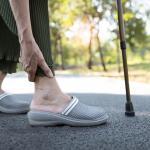
Post-thrombotic syndrome (PTS) is a long-term health condition that can occur after deep vein thrombosis (DVT). Post-thrombotic syndrome symptoms usually impact the legs, affecting mobility and quality of life.
Deep vein thrombosis is a serious condition that develops when a blood clot occurs in the deep venous system. When DVT is left untreated and causes damage to the veins, post-thrombotic syndrome can occur. Initial DVT treatment typically involves the use of blood thinners to dissolve the clot and improve blood flow.
DVT can also lead to pulmonary embolism, which occurs when a piece of the clot breaks off and travels to the lungs. This is a life-threatening condition that requires immediate treatment.
Vein disease, amongst other factors, can increase your risk of developing DVT. If you have vein disease or are at risk for developing it, close monitoring by a vein specialist may be beneficial. At USA Vein Clinics, our experienced specialists usually recommend treating vein disease early on to avoid any progression to serious complications.
Some of our leading-edge treatments include Endovenous Laser Treatment (EVLT) and ClariVein. Treatment usually takes less than an hour from start to finish, allowing you to return immediately to most normal activities.
Below, we discuss post-thrombotic syndrome causes, symptoms, and risk factors. For information about post DVT syndrome treatment that can improve your mobility and quality of life, schedule with a vein specialist online. If you are experiencing signs of DVT, please seek immediate emergency care.
What Causes Post-Thrombotic Syndrome?
Post-thrombotic syndrome is primarily caused by deep vein thrombosis (DVT). The presence of DVT can lead to damage in your vein valves, causing them to malfunction. Similar to when veins are impacted by vein disease, veins affected by post-thrombotic syndrome are unable to efficiently send blood back to the heart. This can lead to painful symptoms, blockages, and additional blood clots.
During exercise or activity, blood flow through the veins is increased. However, for people with DVT or vein disease, veins may not expand to account for the extra blood flow because the vein walls or valves are already weakened or damaged. When veins are unable to accommodate blood flow, you may experience pain and swelling in the legs or ankles. If this condition is not treated, the skin can become damaged and may lead to developing chronic wounds or ulcers. In very severe cases of post-thrombotic syndrome, the vein can be blocked off to the point that blood cannot flow through, which may require amputation if not treated in a timely manner.
Post-Thrombotic Syndrome Symptoms
Many post-thrombotic syndrome symptoms are similar to symptoms of vein disease. Most commonly, the legs are impacted.
Signs of PTS can include:
- Tingling
- Itching
- Heaviness
- Cramping
- Aching
- Swelling
- Pain
PTS is not diagnosed through a test or scan, but through observation of symptoms and pre-existing conditions. If you have vein disease or DVT and experience any of the symptoms above, you may be suffering from post-thrombotic syndrome. However, it is important to consult an experienced specialist to determine what is going on with your individual situation.
Many people with PTS experience leg pain and swelling after long periods of sitting or standing. Physical activity, such as walking or stretching, can help alleviate pain or irritation and promote good blood circulation. To avoid unnecessary discomfort, we suggest getting help from a vein specialist when you first experience leg symptoms. Vein treatment may reduce your risk for developing PTS, painful, non-healing ulcers, and other dangerous conditions.
Post-Thrombotic Syndrome Risk Factors
There are a range of risk factors for post-thrombosis syndrome that are similar to those of vein disease and DVT. Some of these include:
- Sitting or standing for prolonged periods of time
- A recent injury or surgery, especially one requiring lengthy bed rest
- Having a blood-clotting disorder or family history of these disorders
- Smoking
- Varicose veins
- Cancer
- Obesity
- Pregnancy
- Being over age 60
- Underlying health conditions like high blood pressure and diabetes
- Vein disease, or venous insufficiency
If you are at risk for DVT and PTS, we recommend close monitoring by a vein specialist. Individuals with underlying vein disease may benefit from treatment. If you are experiencing signs of DVT or PTS, seek medical evaluation as soon as possible.
Request a Consultation at USA Vein Clinics
If you’re experiencing symptoms of or are at risk for PTS our highly-experienced vein specialists are here to help. At USA Vein Clinics, we specialize in treating a variety of venous issues with minimally invasive, outpatient procedures.
Our team will work with you to develop a personalized plan for treatment and ongoing care. Our primary goal is to improve your vein health, so that you can experience a better quality of life. Schedule online now to visit us at one of our over 100 clinics nationwide or to see a specialist from the comfort of your home with a virtual visit.





